
Photo from wikipedia
Learning Objectives: Recent studies have shown no harm when chest radiographs (CXRs) are performed based on clinical judgement rather than by daily routine. The standard practice in our Medical Intensive… Click to show full abstract
Learning Objectives: Recent studies have shown no harm when chest radiographs (CXRs) are performed based on clinical judgement rather than by daily routine. The standard practice in our Medical Intensive Care Unit (MICU) was to order daily CXRs when patients were endotracheally intubated. Daily morning CXRs were performed between 4:00 am and 7:00 amoften ordered are routine-daily and not discontinued in a timely manner in the electronic medical record (EMR). This project aimed to reduce the number of unnecessary CXRs performed in the MICU. Other potential benefits included: reduce health care costs, eliminate patient exposure to unnecessary radiation, improve patient’s sleep quality, and optimize utilization of radiology staff. Methods: Three separate intervention phases were utilized to reduce daily routine CXRs between October 2014, and February 2018. We included MICU and endotracheally intubated patients and excluded non-intubated and tracheotomy patient in this same unit, while excluding Surgical ICU (SICU) patients. Phase 1: Staff survey was performed to understand CXR ordering practices, journal club was organized to discuss with critical care providers that low value of routine-daily CXR and the higher value of on-demand CXR, “Does my patient need a CXR tomorrow?” posters strategically placed in work-rooms, and daily CXR order was removed from the ICU admission order set. Phase 2: Duplicate CXR pop-up alert was introduced to EMR. Phase 3: Ordering Staff re-surveyed, visual reminders CXR/Ultrasound pocket cards distributed, Empower Nursing and Radiology staff to verify with critical care provider if they suspect unnecessary CXRs were ordered. Electronic CXR clinical decision support tool implemented in EMR. Results: Total number of CXR/patient-day in the MICU during study period decreased from 0.59 to 0.38, corresponding to 36.1% reduction. Proportion of “routine” CXRs being ordered went from 55.37% to 13.18%. The number of “on demand” CXR went from 44.63% to 86.82%. Calculated radiation exposure per patient-day went from 0.011 mSV to 0.008 mSv. The cost to patients of CXRs decreased by $31,000. Finally, counter balance measures including: ICU mortality ratio and ventilator days/census ratio remained stable. Conclusions: By an orchestrated process that includes creating awareness and desire to change CXR ordering practices, we were able to decrease the number of CXR performed, decreasing routine CXR, and increasing on-demand utilization while maintaining counterbalance measure.
Journal Title: Critical Care Medicine
Year Published: 2019
Link to full text (if available)
Share on Social Media: Sign Up to like & get
recommendations!